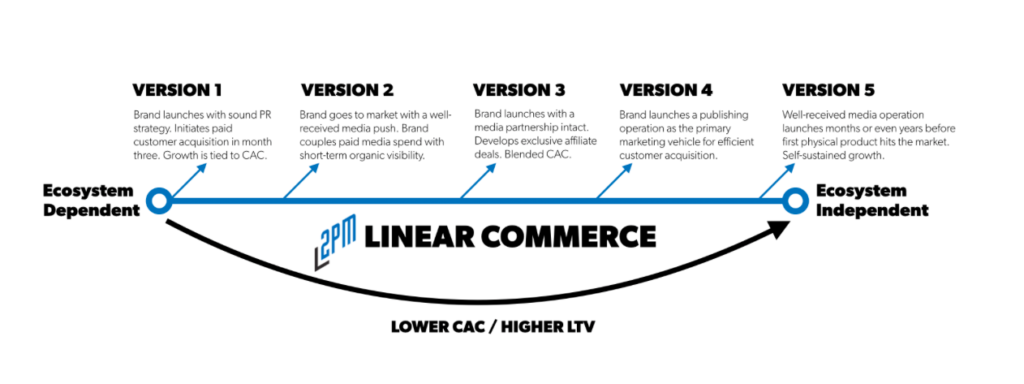(Part 3)
Another perspective on leveraging one’s direct relationship with an audience is the idea of Linear Commerce:
Law of Linear Commerce: the lines of demarcation between media and commerce are fading. For the brands that are most suited to the modern retail economy: media and commerce operations work to optimize for audience and sales conversion. This is the efficient path for sustained growth, retention, and profitability.
– On Linear Commerce, Web Smith.
Smith, quoted on another site:
The Law of Linear Commerce is the prioritization of audience. Product manufacturers typically seek to outsource demand generation. Brands, that are ahead of the curve, emphasize their audience’s growth as much as they do their physical product’s development. Likewise, digital media publishers that follow linear commerce principles prioritize organic and loyal audience growth over SEO or PPC-driven commodity clicks.
Smith uses this graphic to describe the ongoing evolution from the current norm of buying audiences to the other extreme, media-first commerce:

One of the examples of a Level 5 company Smith describes is Glossier, a cosmetics company.
The best practical example of the Version 5 launch plan was Emily Weiss’ go-to-market strategy. Into the Gloss began as the primary sales driver for Glossier’s line of makeup and accessories. A newly minted unicorn, Glossier.com‘s 2.6 million monthly visitors now arrive from a sustainable blend of customer acquisition methods: organic traffic through Into The Gloss and Instagram, paid search, Facebook / Instagram advertising, and a quiet affiliate deal with BuzzFeed. Here is Emily Weiss on Glossier’s growth:
We are building an entirely new kind of beauty company: one that owns the distribution channel and makes customers our stakeholders. By connecting directly with consumers, Glossier has access to endless inspiration for new products.
This other site has yet another example:
Nelk started as a prank channel on YouTube. Over the years, they’ve evolved into more of a lifestyle vlogging channel…
When they drop a new line of products, it’s always limited and it always sells out. Usually within minutes. They tie their product drops seamlessly with the antics, catch phrases, etc. from their vlogs. These all become products sold on http://fullsend.com. They started with clothing, but have expanded—bottle openers, flags—you name it.
That is the low hanging fruit. Nelk didn’t stop there. They’ve excellently tied their content roadmap directly to the future products they sell. Here’s an example 👇
A year ago or so, a fitness-focused Youtuber, Bradley Martin, started showing up in their weekly videos. Bradley became a staple in many Nelk vlogs. And so the Nelk crew started working out and talking about fitness regularly. Fitness became a core part of their vlogs. This wasn’t random. It was a well-thought out plan that deeply connected their content to commerce strategy. Yesterday they launched http://fullsendsupps.com— branded line of fitness supplements. Guess what? It fully sold out. In less than 1 day!
You can see how this goes well beyond simply being an influencer with a following that features sponsored products.
A Level 5 Linear Commerce company is a combination of a full-fledged media brand that has a fan following in its own right whose content is closely tied to the roadmap of that brand’s own products. The roadmap itself is influenced by the audience’s desires, forming a virtuous cycle.
